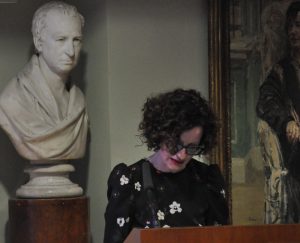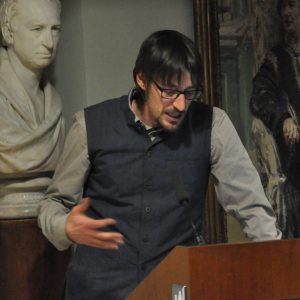Source Detection, Book Launches, and Imperial Policing
Following Professor Christopher Fuller’s recent lecture at the Society, “European Science and Colonial Anthropology in British India, c. 1871-1911”, we’re on the hunt for a source used by Herbert Risley (1851-1911) in his interpretation of a panel at Sanchi, India.
In the passage below, Prof. Fuller describes Risley’s interpretation of a Sanchi panel, with the key parts in bold. Does anyone know what source Risley used as a basis to identify the characters as representing Aryans and Dravidians?
“For Risley himself – as well as his colleagues and critics in India – the most important topics were caste and race, and the relationship between them that was the basis for his racial theory of caste. In The Tribes and Castes of Bengal: Ethnographic Glossary (1891), the introduction’s opening paragraph described a carved stone panel on a gateway at the Buddhist sacred complex at Sanchi, which depicts monkeys offering a bowl of honey to the Buddha, represented by his pipal tree and throne. Watching the monkeys in an attitude of reverence are two men and two women, who are taller than the monkeys and dressed in a style displaying their high status (John Marshall, Guide to Sanchi (1918), p. 58). The handbook’s cover was decorated with a design based on this panel. Without citing any supporting evidence, Risley claimed the panel was a ‘sculptured expression of the race sentiment of the Aryans towards the Dravidians’, and showed ‘the higher race’ – represented by the tall figures – ‘on friendly terms with the lower’ – the monkeys – but conscious of the difference between them and appearing only ‘as patronising spectators’. Hence the sculpture depicted the ‘race sentiment’ that shaped the caste system and ‘preserved the Aryan type in comparative purity’ in north India (pp., i-ii). Risley’s article on race and politics (‘The race basis of Indian political movements’, The Contemporary Review, 1890), and later his 1901 census report chapter (Caste, tribe and race’) and his book The people of India (1908, 1915), included the same passage about the sculpture, so he was obviously sure about its telling significance. But why he thought it represented Aryans and Dravidians is not clear, and at least one later critic of his racial theory of caste, Harikishan Kaul, the 1911 Punjab census superintendent, reasonably objected that the Sanchi panel was just a Buddhist sculpture, a ‘simple religious picture, having nothing whatever to do with race’ (1911 Punjab Census Report, p. 400).”
If anyone can shed any light on Risley’s source, please let us know!

Our new term of events is now in full swing, and this week saw three books launched at the RAS on Wednesday evening. Elisabetta Iob introduced her book, Refugees and the Politics of the Everyday State in Pakistan: Resettlement in Punjab, 1947-1962, before handing over to Uther Charlton-Stevens to tell us about his new publication, Anglo-Indians and Minority Politics in South Asia: Race, Boundary Making and Communal Nationalism.

Finally, Tommaso Bobbio discussed his work on Urbanisation, Citizenship and Conflict in India: Ahmedabad 1900-2000. The presentations were followed by a discussion, chaired by Francis Robinson, and a reception. All three books are published by the RAS in partnership with Routledge and are available here: https://www.routledge.com/Royal-Asiatic-Society-Books/book-series/RAS.

On Thursday 18th January, Dr Mark Condos gave the next lecture in the RAS Series, speaking on “Anarchists, Revolutionaries and Franco-British Imperial Policing in French Chandernagore, 1905-1930”. His lecture took us right back to early extradition legislation but mainly concentrated on the French/English interactions in dealing with Indian nationalist revolutionaries in the period after the Delhi Bomb Outrage which sought to kill Viceroy Hardinge.

We are very grateful to all our lecturers who help to create such an active and research-filled programme at the RAS. Our next lecture will be on Tuesday 23rd January at 6.30pm, when Dr Alban von Stockhausen from the Bernisches Historisches Museum in Bern, will lecture on “Images and (Post)colonial Encounters: A History of the Visual Representation of the Nagas of Northeast India”. We look forward to welcoming you to this event.
